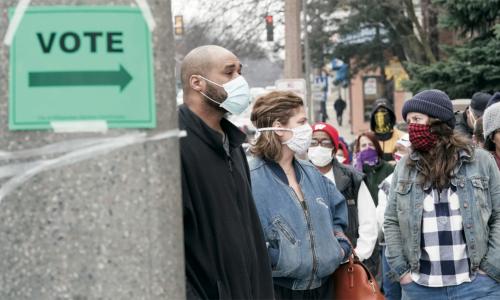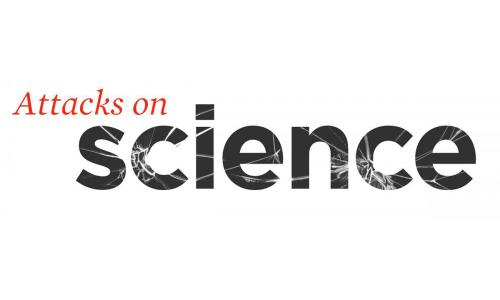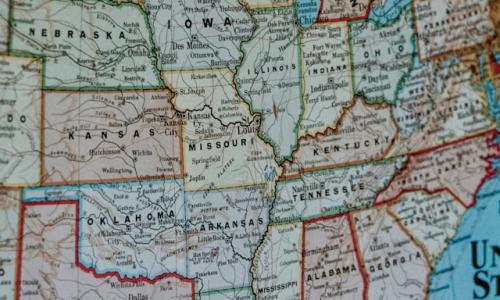As of July 2020, the COVID-19 pandemic has killed more than 100,000 people in the United States and sickened many more. It has cost millions of Americans their jobs and disrupted people's lives in countless large and small ways. Now, it’s coming for our democracy, endangering the November 2020 election.
The virus presents multiple challenges for electoral systems, and already sixteen states have postponed their primaries in the face of these challenges. But the November election can’t be delayed. To avoid a nationwide breakdown, states must act immediately to provide the resources and protections needed to ensure that we can all vote without risking our lives.
It’s important to remember that the pandemic has struck an electoral system already plagued by entrenched inequities that make it more difficult for members of Black, Indigenous, Latinx, and other marginalized communities to exercise their right to vote. These same communities also face the greatest risk from problems—such as air pollution, climate change, and COVID-19 itself—that require government action to address. So electoral reform was already a pressing problem for our nation—and the pandemic has made it even more urgent.
On top of the safety challenges the pandemic has created, we are also seeing extraordinary levels of voter disinformation and suppression. With our democracy on the line, we need everyone to help combat this by sharing concrete tips and tools for debunking voter disinformation and the steps to ensuring every vote is counted.
How ready are the states for November?
Our analysis focused on three key factors affecting state preparedness for this year's election. States are grouped from most prepared (dark blue) to least prepared (light blue). Values reflect state policies as of June 2020.
What states need to do
We’ve identified four key strategies for making free, fair, safe November elections possible in the face of COVID-19:
Make registering from home easy
Face-to-face voter registration procedures are unsafe during the pandemic, so states need to provide other ways for eligible voters to update their registration status. Only 18 states have automatic voter registration, which is both eligible and secure. Other options like online registration are more widespread, but often include requirements that limit access. All states should offer accessible online registration along with same-day registration.
Make voting by mail easy
The safest way for people to vote this November is for every eligible voter to receive a ballot in the mail that can be returned in a self-adhesive, postage-paid envelope or dropped off at a secure ballot box. Unfortunately, too many states are behind the curve on vote-by-mail. Scaling up capacity is crucial. It will require removing legal barriers, expanding states’ capacity to handle mail ballots, investing in the US Postal Service, and implementing technology to allow voters to track their ballots.
Ensure safe, accessible in-person voting
Millions of Americans, due to disabilities or other factors, have no option but to vote in person. To meet their needs, states should establish strategically located voting centers and keep them open for at least two weeks before Election Day to prevent long lines and crowded polling places. By following Centers for Disease Control and Prevention guidelines for precinct hygiene and sanitation, states can make in-person voting a safe option for those who need it, ensuring that all voters have an equal opportunity to exercise their right to vote.
Guarantee an accurate, secure election count
Expansion of mail-in voting will require transparent and rigorous processes to verify ballots—including training for verification judges—and to ensure that voters have an adequate opportunity to correct ballot errors. Election officials also need time to process and validate election results accurately, which means that election results in many places won’t be available on election night. To maintain public confidence in the election process, states will need to work with local media and political organizations to ensure that the public is receiving accurate information. It will take months to put these procedures in place.
What we can do: resources for learning and action
We can still have a free, fair, safe election this November. But there’s no time to lose. Here's a suite of resources for you to learn more—and take action.
Act
- Download, use, and share our partner toolkit for protecting public health in the 2020 elections
- Write a letter to the editor to help combat voter disinformation
- If you're an expert in medicine, public health, political science, or election administration experts, join our open letter making the case for safe voting reform
- Share this educational video (en español) with information on vote-by-mail and early voting on social media
- Volunteer with Election Protection, the nation's largest nonpartisan voter protection coalition, at 866ourvote.org.
Learn
- Report: Protecting Public Health in the 2020 Elections from UCLA Voting Rights Project, Voting Rights Lab, and UCS
- Voting fact sheets that you can adapt for your own organization's efforts: National | Arizona (English) | Arizona (Spanish) | Michigan | North Carolina
- Learn more about the intersection of voting rights and environmental justice—and how you can be part of it.
Additional resources
Web tools
- Learn more about how voting works in your state using the WeCanVote app.
- Keep up with changes in your state’s election laws with the Voting Rights Tracker.
Research
- Brennan Center for Justice
- UCLA Voting Rights Project
- Fair Elections During a Crisis from the UC Irvine School of Law Ad Hoc Committee for 2020 Election Fairness and Legitimacy
- National Taskforce on Election Crises




